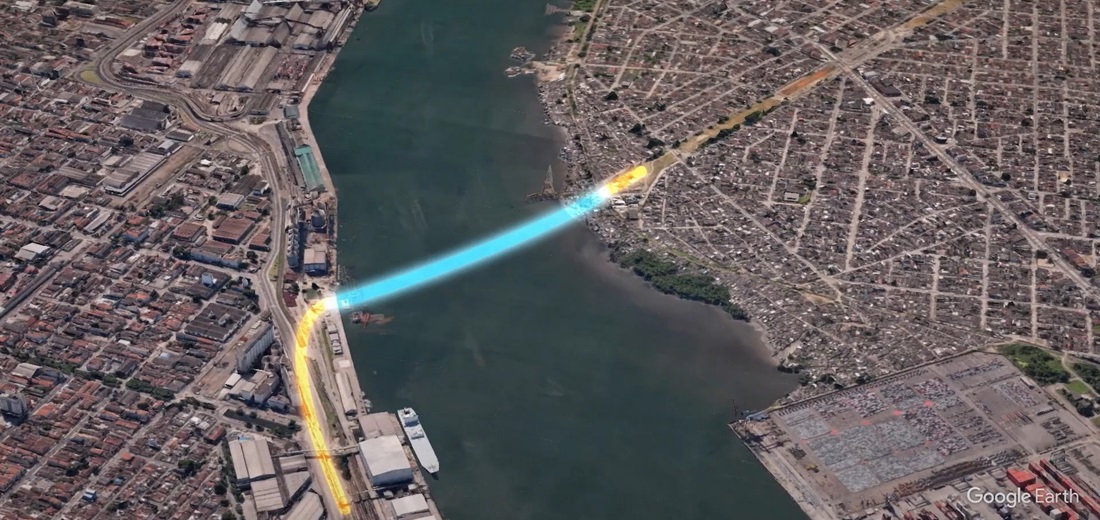
Santos-Guarujá Tunnel Construction Designed To Not Disrupt Port Operations
May, 15, 2024 Posted by Gabriel MalheirosWeek 202420
The president of the Santos Port Authority (APS), Anderson Pomini, assures that the construction of the Santos-Guarujá tunnel will not disrupt the passage of ships through the port’s access channel.
“Technicians have assured us that during the placement of the pre-molded tunnel sections, only part of the channel will be blocked, allowing port operations to continue. Each movement will be coordinated with port operators,” Pomini stated.
The underwater tunnel construction between Santos and Guarujá is moving forward, transforming from a long-discussed idea into a tangible solution for transportation between the two cities.
Three public hearings were held between April 18 and 19, alongside an online public consultation. According to the reference schedule, the notice for the project is expected to be published in March of next year, with the bidding process slated for July. This project piques curiosity: how is a tunnel constructed in an estuary?
The 2014 Dersa project, which serves as a basis, outlines the process for constructing and installing the tunnel modules 21 meters below the water line.
To grasp the importance of the Port of Santos, one has to know that it is the busiest in South America. The chart below shows maritime imports and exports of containers handled at the port. The information was derived from DataLiner.
Container Exp & Imp | Port of Santos | Jan 2021 – Mar 2024 | TEUs
Source: DataLiner (click here to request a demo)
Dry Dock
“The first step is to determine the location of the dry dock, where the tunnel modules to be installed in the port’s navigation channel will be built,” explained APS project supervisor Reginaldo Ortega.
Ortega emphasized that the ideal location for this structure is as close as possible to the installation site to minimize transport issues.
“The chosen shipyard type could be either a temporary one (in a location that is equipped for assembly and disassembly efforts at the end of the construction process) or, if possible, an already operational shipyard. In the case of Santos and Guarujá, no permanent structure meets our needs.”
The 2014 project involves six immersive modules, with the dry dock producing three modules at a time. Constructing this dock was estimated to take 12 months, with each set of three modules taking eight months for construction and two months for flooding and drying operations.
The upper structure of the completed tunnel will also allow for future dredging without interfering with port operations.
Construction Steps
1. Soil Preparation
A trench is dredged for the future placement of concrete slabs to house the tunnel modules. This process takes 14 months to complete, without interruptions to the navigation channel.
2. Construction
The tunnel elements are concrete pieces constructed in a dry dock. They have temporary water pools inside them, which prevent the structure from sinking at the first moment.
3. Transport
Once the pieces are ready, they undergo sealing tests. The dry dock is then flooded, causing the elements to float. Tugboats then transport them to the tunnel location.
4. Positioning
The elements are fixed to floating bridges and positioned by electronic systems at the exact location where they will be immersed.
5. Submersion
The water inside the temporary pools within the modules is pumped out, submerging the tunnel elements. This process is monitored by sensors.
6. Connection of Elements
Using hydraulic winches, the elements are brought together until they touch each other. The operation is monitored by sensors and accompanied by divers.
7. Docking
The modules are joined by the difference in atmospheric pressure inside the already positioned element and the water pressure on the new element. When two modules are docked and the initial joints are adequately sealed, the water is removed from the structures.
8. Leveling
At one end of the element, hydraulic jacks are anchored, which move steel pins to level the modules.
9. Protection
Finally, a layer of stones is used to cover and protect the tunnel against impacts from boats and the hooking of loose anchors.
Source: A Tribuna
Click here to read the original news report: https://www.atribuna.com.br/noticias/portomar/construcao-do-tunel-santos-guaruja-vai-interditar-o-canal-do-porto
-
Economy
Sep, 08, 2020
0
TRADE BALANCE SURPLUS REACHES US $ 1.795 BILLION IN FIRST WEEK OF SEPTEMBER
-
Other Cargo
Oct, 13, 2021
0
Government discusses fertilizer offer with major Russian manufacturers
-
Ports and Terminals
Dec, 22, 2021
0
Port of Los Angeles to test manure-derived hydrogen fuel
-
Other Logistics
Jan, 11, 2024
0
Rumo Achieves Yearly Targets with a 15% Surge in Transported Volumes for December

